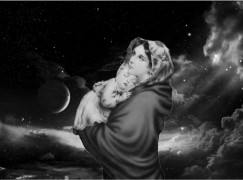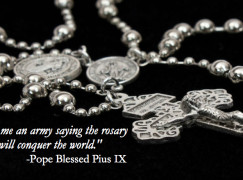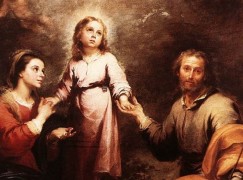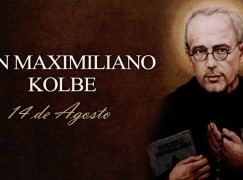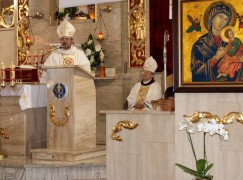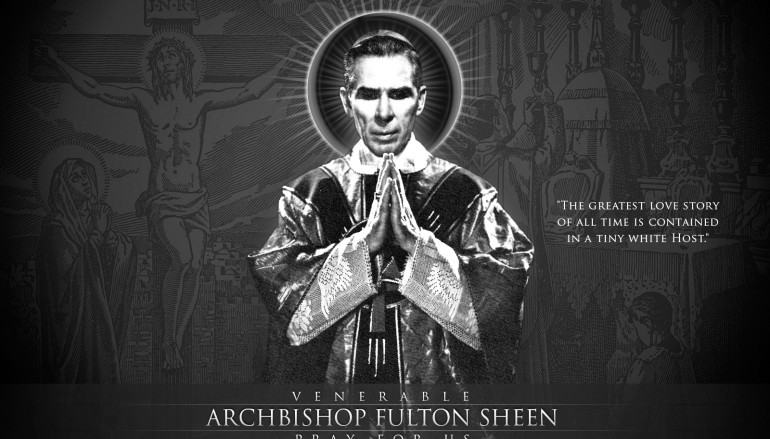

Part Three – Calvary and the Mass – The Sanctus
PART THREE – THE SANCTUS
by Archbishop Fulton J. Sheen, Ph.D., D.D., LL.D., Litt.D.
“Woman, behold thy son . . . behold thy mother.”-John 19:26-27.
Five days ago our Blessed Lord made a triumphal entry into the city of Jerusalem: Triumphant cries rang about His ears; palms dropped beneath His feet, as the air resounded with hosannas to the Son of David and praises to the Holy One of Israel. To those who would have silenced the demonstration in His honor, our Lord reminds them that if their voices were silent, even the very stones would have cried out. That was the birthday of Gothic Cathedrals.
They did not know the real reason why they were calling Him holy; they did not even understand why He accepted the tribute of their praise. They thought that they were proclaiming Him a kind of earthly king. But He accepted their demonstration because He was going to be the King of a spiritual empire. He accepted their tributes, their hosannas, their paens of praise because He was going to His cross as a Victim. And every victim must be holy- Sanctus, Sanctus, Sanctus. Five days later came the Sanctus of the Mass of Calvary. But at that Sanctus of His Mass, He does not say “holy” –He speaks to the holy ones; He does not whisper “Sanctus”-He addresses Himself to saints, to His sweet Mother Mary, and His beloved disciple, John.
Striking words they are: “Woman, behold thy son . . . behold thy mother.” He was speaking now to saints. He had no need of saintly intercession, for He was the Holy One of God. But we have need of holiness, for every victim of the Mass must be holy, undefiled, and unpolluted. But how can we be holy participants in the Sacrifice of the Mass? He gave the answer: namely, by putting ourselves under the protection of His Blessed Mother. He addresses the Church and all its members in the person of John, and says to each of us: “Behold thy mother.” That is why He addressed her not as “Mother” but as “Woman.” She had a universal mission, to be not only His Mother, but to be the Mother of all Christians. She had been His Mother; now she was to be the Mother of His Mystical Body, the Church. And we were to be her children.
There is a tremendous mystery hidden in that one word “Woman.” It was really the last lesson in detachment which Jesus had been teaching her these many years, and the first lesson of the new attachment. Our Lord had been gradually “alienating,” as it were, His affections from His Mother, not in the sense that she was to love Him less, or that He was to love her less, but only in the sense that she was to love us more. She was to be detached from motherhood in the flesh, only to be more attached to that greater motherhood in the spirit. Hence the word: “Woman.” She was to make us other Christs, for as Mary had raised the Holy One of God, so only she could raise us as holy ones for God, worthy to say Sanctus, Sanctus, Sanctus, in the Mass of that prolonged Calvary. The story of the preparation for her role as Mother of the Mystical Body of Christ is unfolded in three scenes in the life of her divine Son, each one suggesting the lesson which Calvary itself was to reveal: namely, that she was called to be not only the Mother of God, but also the Mother of men: not only the Mother of holiness, but the Mother of those who ask to be holy.
The first scene took place in the Temple where Mary and Joseph found Jesus after a three-day search. The Blessed Mother reminds Him that their hearts were broken with sorrow during the long search, and He answers: “Did you not know that I must be about my Father’s business?” Here He was equivalently saying: “I have another business, Mother, than the business of the carpenter shop. My Father has sent Me into this world on the supreme business of Redemption, to make all men adopted sons of My heavenly Father in the greater kingdom of the brotherhood of Christ, Thy Son.” How far the full vision of those words dawned upon Mary, we know not; whether she then understood that the Fatherhood of God meant that she was to be the Mother of men, we know not. But certainly, eighteen years later, in the second scene, the marriage feast of Cana, she came to a fuller understanding of that mission.
What a consoling thought it is to think that our Blessed Lord, who talked penance, who preached mortification, who insisted upon taking up the cross daily and following Him, should have begun His public life by assisting at a wedding festival! What a beautiful understanding of our hearts! When in the course of the banquet the wine was exhausted, Mary, always interested in others, was the first to notice and the first to seek relief from the embarrassment. She simply said to our Blessed Lord, “They have no wine.” And our Blessed Lord said to her, “Woman, what is that to me and to thee? My hour is not yet come.” “Woman, what is that to me?” He did not call her “Mother,” but “Woman”-the same title she was to receive three years later.
He was equivalently saying to her: “You are asking Me to do something which belongs to Me as the Son of God. You are asking Me to work a miracle which only God can work; you are asking Me to exercise My divinity which has relationship to all mankind, namely as its Redeemer. But once that divinity operates for the salvation of the world, you become not only My Mother, but the Mother of redeemed humanity. Your physical motherhood passes into the wider world of spiritual motherhood, and for that reason I call you: ‘Woman.'” And in order to prove that her intercession is powerful in that role of universal motherhood, He ordered the pots filled with water, and in the language of Crashaw the first miracle was worked: “the conscious waters saw their God and blushed.”
The third scene happens within two years. One day as our Lord was preaching someone interrupted His discourse to say, “Thy mother . . . stands without, seeking thee.” Our Blessed Lord said, “Who is my mother?” and stretching forth His hands toward His disciples He said: “Behold my mother and my brethren. For whosoever shall do the will of my Father, that is in heaven, he is my brother, and my sister, and mother.” The meaning was unmistakable. There is such a thing as spiritual maternity; there are bonds other than those of the flesh; there are ties other than the ties of blood, namely spiritual ties which band together those of the Kingdom where reign the Fatherhood of God and the Brotherhood of Christ.
These three scenes have their climax at the Cross where Mary is called “Woman.” It was the second Annunciation. The angel said to her in the first: “Hail, Mary.” Her Son speaks to her in the second: “Woman.” This did not mean she ceased to be His Mother; she is always the Mother of God; but her Motherhood enlarged and expanded; it became spiritual, it became universal, for at that moment she became our mother. Our Lord created the bond where it did not exist by nature as only He could do. And how did she become the Mother of men? By becoming not only the mother, but also the spouse of Christ. He was the new Adam, she is the new Eve. And as Adam and Eve brought forth their natural progeny, which we are, so Christ and His Mother brought forth at the cross their spiritual progeny, which we are: children of Mary, or members of the Mystical Body of Christ. She brought forth her First-born at Bethlehem.
Note that St. Luke calls our Lord the First-born -not that our Blessed Mother was to have other children according to the flesh, but only because she was to have other children according to the spirit. That moment when our Blessed Lord said to her, “Woman,” she became in a certain sense the spouse of Christ and she brought forth in sorrow her first-born in the spirit, and his name was John. Who the second-born was we know not. It might have been Peter. It might have been Andrew. But we at any rate are the millionth-and-millionth-born of that woman at the foot of the Cross. It was a poor exchange indeed, receiving the son of Zebedee in place of the Son of God. But surely our gain was greater, for while she acquired but undutiful and often rebellious children, we obtained the most loving Mother in the world -the Mother of Jesus.
We are children of Mary-literally, children. She is our Mother, not by title of fiction, not by title of courtesy; she is our Mother because she endured at that particular moment the pains of childbirth for all of us. And why did our Lord give her to us as Mother? Because He knew we could never be holy without her. He came to us through her purity, and only through her purity can we go back to her. There is no Sanctus apart from Mary. Every victim that mounts that altar under the species of bread and wine, must have said the Confiteor, and become a holy victim-but there is no holiness without Mary.
Note that when that word was spoken to our Blessed Mother, there was another woman there who was prostrate. Have you ever remarked that practically every traditional representation of the Crucifixion always pictures Magdalene on her knees at the foot of the crucifix? But you have never yet seen an image of the Blessed Mother prostrate. John was there and he tells in his Gospel that she stood. He saw her stand. But why did she stand? She stood to be of service to us. She stood to be our minister, our Mother. If Mary could have prostrated herself at that moment as Magdalene did, if she could have only wept, her sorrow would have had an outlet. The sorrow that cries is never the sorrow that breaks the heart. It is the heart that can find no outlet in the fountain of tears which cracks; it is the heart that cannot have an emotional break-down that breaks. And all that sorrow was part of our purchase price paid by our Co-Redemptrix, Mary the Mother of God!
Because our Lord willed her to us as our Mother, He left her on this earth after He ascended into heaven, in order that she might mother the infant Church. The infant Church had need of a mother, just as the infant Christ. She had to remain on earth until her family had grown. That is why we find her on Pentecost abiding in prayer with the Apostles, awaiting the descent of the Holy Ghost. She was mothering the Mystical Body of Christ.
Now she is crowned in heaven as Queen of Angels and Saints, turning heaven into another marriage feast of Cana when she intercedes with her divine Saviour in behalf of us, her other children, brothers of Christ and sons of the heavenly Father. Virgin Mother! What a beautiful conjunction of virginity and motherhood, one supplying the defect of the other. Virginity alone lacks something: there is an incompleteness about it; something unfulfilled; a faculty unused. Motherhood alone loses something: there is a surrender, an unflowering, a plucking of a blossom. Oh! for a rapprochement in which there would be a virginity that never lacked anything, and a motherhood that never lost anything! We have both in Mary, the Virgin Mother: Virgin by the overshadowing of the Holy Spirit in Bethlehem and Pentecost; Mother by the millions of her progeny from Jesus unto you and me.
There is no question here of confusing our Lady and our Lord; we venerate our Mother, we worship our Lord. We ask of Jesus those things which only God can give: mercy, grace, forgiveness. We ask that Mary should intercede for us with Him, and especially at the hour of our death. Because of her nearness to Jesus which her vocation involves, we know our Lord listens especially to her appeal. To no other saint can we speak as a child to its mother: no other virgin, or martyr, or mother, or confessor has ever suffered as much for us as she has; no one has ever established better claim to our love and patronage than she.
As the Mediatrix of all graces, all favors come to us from Jesus through her, as Jesus himself came to us through her. We wish to be holy, but we know there is no holiness without her, for she was the gift of Jesus to us at the Sanctus of His Cross. No woman can ever forget the child of her womb; then certainly Mary can never forget us. That is why we feel way down deep in our hearts that every time she sees another innocent child at the First Communion rail, or another penitent sinner making his way to the Cross, or another broken heart pleading that the water of a wasted life be changed into the wine of God’s love, that she hears once again that word: “Woman, behold thy son.”


